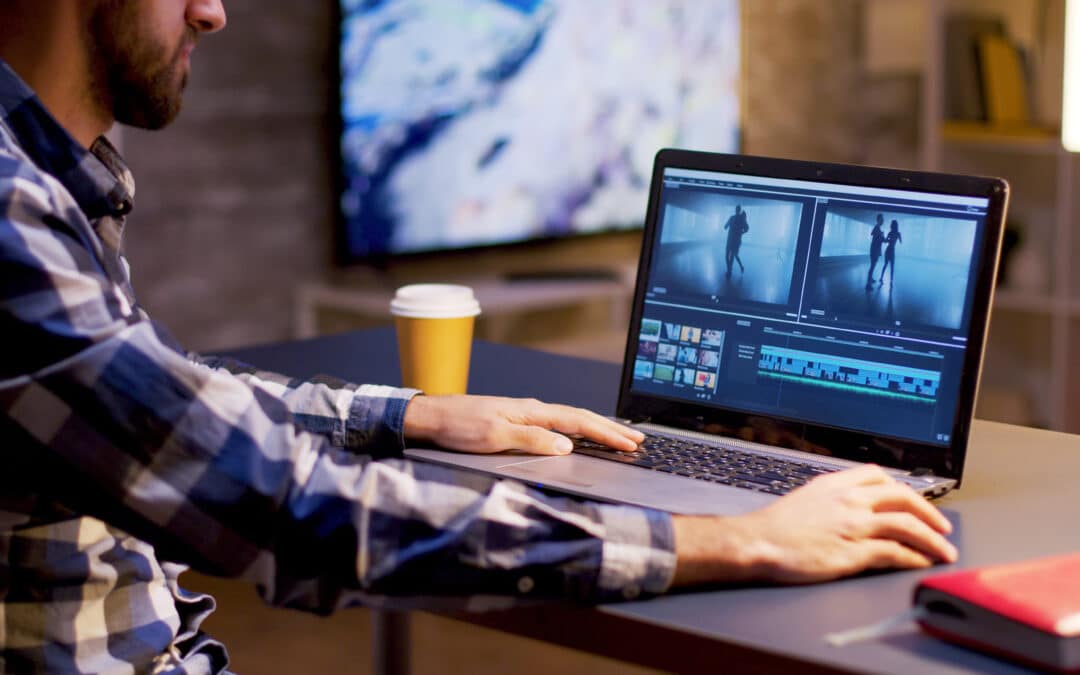It’s no secret the future of social media is video content. According to HubSpot, 86% of businesses are using video in their content strategy in 2021. Whether that be a live or on-demand video, you need to know how to film a video and where to upload it effectively. Before you go out there and start your video production, read this article to fully understand how to be successful.
Video Production Basics
Before I get into the specifics about filming and video production for social media platforms, I’d like to start with some general knowledge about filming.
According to Social Bakers, the most important step in filming for social media is planning. This may seem obvious, but careful planning can avoid issues that could otherwise be disastrous. It is best to brainstorm, compile data, have a workable script and establish a budget before you even pick up the camera. Producing a high-quality video is easier said than done, but planning will make it easier.
Choosing Your Video Production Equipment
There is a ton of equipment involved in video production, but the three most important pieces are a camera, a lighting kit and a microphone.
A lighting kit may sound like something you can skip, but effective lighting is what separates amateur videos from professional ones. Desktop Documentaries recommends using a camera light as a nice way to fill in unwanted shadows, but if you are filming mostly indoors, they recommend using a full three-point lighting kit.
Camera equipment can get expensive in a hurry. Luckily if you can’t afford a new camera, almost all of us have a smartphone that is capable of taking high-quality videos. To ensure you get the best video quality, use a tripod to stabilize your camera and avoid the zoom feature if you are filming on a phone; your footage won’t look as good. If you plan on making a lot of videos and want the best quality, go to Desktop Documentaries to find the perfect camera for you.
 It won’t matter how good your video is if you don’t also capture pristine audio. Desktop Documentaries recommends using a shotgun microphone. Bring a shock mount, which can easily turn your shotgun mic into a boom mic. If you plan to shoot video outside, buy a windsock for the microphone, which will block wind from interfering with the audio quality. If you are recording audio for voice-over projects, use wired or wireless mics attached to the apparel of the person talking. Doing this will give you crisp audio that is easy to work with.
It won’t matter how good your video is if you don’t also capture pristine audio. Desktop Documentaries recommends using a shotgun microphone. Bring a shock mount, which can easily turn your shotgun mic into a boom mic. If you plan to shoot video outside, buy a windsock for the microphone, which will block wind from interfering with the audio quality. If you are recording audio for voice-over projects, use wired or wireless mics attached to the apparel of the person talking. Doing this will give you crisp audio that is easy to work with.
Keep in mind there is too much equipment to talk about in this one article, so conduct your own research to find the best fit for your video production. For now, let’s move on to the specifics for the different social media platforms.
Video Production Tips For Social Media
Social Media Video Tips: Snapchat
Snapchat is a straightforward platform when it comes to posting social media video. It is fine to film vertically or horizontally; the videos can be 10 seconds long and work well for targeting the younger generation.
Snapchat video production is a perfect opportunity to use your phone for filming, and you can use the filter features Snapchat offers to give your video an extra flair of personality. You don’t want to spend too much time on this social media platform, as it doesn’t receive as much engagement as the others and other platforms have eclipsed it in popularity.
Snapchat also offers a long-form ad option, but if you want to invest in advertising, you need to reach out to Snapchat to get the details.
Quick Snapchat video production guidelines:
- Recommended size is 1080p x 1920p (aspect ratio of 9:16)
- Max file size is 32MB (1 GB for long-form ads)
- Accept video formats are .MP4 and .MOV
- Video length is between 3 and 10 seconds (no maximum for long-form ads; minimum of 15 seconds)
Social Media Video Production Tips: TikTok
TikTok is the newest social media platform that has taken the world by storm and is solely focused on video content. Originally designed to use mobile devices to shoot, edit and share, this platform is relatively easy to use. With its mobile focus, videos need to be short and entertaining.
Quick TikTok video production guidelines.
- Recommended resolution: 1080×1920
- Aspect ratio: 9:16 recommended to fill a standard mobile phone screen (1:1 with letterboxing)
- Length: 15 seconds recorded in-app, 60 seconds in-app (4 sections of 15 seconds), or over 60 seconds when uploaded from another source
- Maximum file size: 287.6MB
- Video formats: MP4 or MOV recommended
Social Media Video Tips: Facebook
 Facebook is a fantastic social media platform for posting videos. According to Sprout Social, Facebook video is consumed at higher rates each year, and people tend to want to watch at least 1 hour of Facebook videos per week. Facebook offers a variety of video options, such as live videos, Stories and on-demand videos. Unless you are filming for Facebook Stories, make sure to film horizontally.
Facebook is a fantastic social media platform for posting videos. According to Sprout Social, Facebook video is consumed at higher rates each year, and people tend to want to watch at least 1 hour of Facebook videos per week. Facebook offers a variety of video options, such as live videos, Stories and on-demand videos. Unless you are filming for Facebook Stories, make sure to film horizontally.
Facebook also offers several other visual options, like carousel posts, 360° video, and Newsfeed videos. Filming for these can become quite complicated, however, especially for 360, as you need special equipment to do it correctly.
Quick Facebook video production guidelines:
- Recommended video dimensions are
- 1280p x 720p for landscape and portrait
- 2:1 aspect ratio
- Videos cannot be longer than 240 minutes
- Frame rate cannot exceed 30 FPS
- Minimum width is 600p
- Landscape aspect ratio is 16:9
- Portrait aspect ratio is 9:16 (but avoid it when you can)
- Max file size is 4GB
- Recommended video formats .MP4 and .MOV
Video Production Tips: LinkedIn
When it comes to video content, LinkedIn is still in the early stages of implementation. That being said, according to Sprout Social, 75% of business executives say they watch online videos every week. As LinkedIn is the most professional social media site and is widely used, you will want to post business-appropriate video content to LinkedIn, but avoid sharing videos that are not finely polished. Make sure you use your best equipment when filming and remember to get to the point. Your video needs to be quick, catchy and precise if you want to keep their attention.
Quick LinkedIn video production guidelines:
- Minimum file size: 75KB
- Maximum file size: 5GB
- Videos can be uploaded horizontally or vertically (do not upload them vertically unless you have no other options)
- Minimum video length is 3 seconds and maximum video length is 10 minutes
- Recommend file types: .ASF, .AVI, .FLV, .MOV, .MPEG-1, .MPEG-4
- Video max frame rate is 60 FPS
- Aspect ratio: 1:2.4 or 2.4:1
- Resolution range: 256×144 to 4096×2304
Social Media Video Tips: Instagram
Instagram is a very popular social media platform among younger generations. So, when you share a video on Instagram, make sure it is geared toward the youngest members of your target audience. Instagram is the one platform where you need to film vertically. Instagram’s aspect ratio is 4:5, while most video ratios are 9:16, so whether you are filming for Stories our just your profile, it is best to film vertically.
Instagram has a feature called IGTV, which is Instagram’s attempt to get more people to use their platform for video. These videos can be as long as 10 minutes and should be formatted the same way as YouTube. IGTV is still growing in popularity, so if you put your best content on the platform, you should see an excellent return.
Quick Instagram video production guidelines:
- Square video: 600p x 600p (1:1 aspect ratio)
- Horizontal video: 600p x 315p (1.9:1 aspect ratio)
- Vertical video: 600p by 750p (4:5 aspect ratio)
- Instagram stories: 1080p x 1920p (16:9, 4:5 and 9:16 aspect ratios)
- IGTV videos: 1080p x 1920p (9:16 aspect ratio)
- Max file size is 4GB
- Recommended video formats are .MP4 and .MOV
- Video length max is 60 seconds for stories and 10 minutes for IGTV
- Video max frame rate is 30 FPS
Social Media Video Tips: Twitter
Twitter is one of the fastest-moving social media platforms, which is why you can only post videos that last 140 seconds (just over 2 minutes). Videos on this channel have to be entertaining and prompt. Twitter is mainly used for things like sharing news about sports, politics and entertainment. If you have videos in any of those categories, this could be a fantastic platform for your brand.
Quick Twitter video production guidelines:
- Minimum dimensions: 32 x 32p
- Maximum dimensions: 1920 x 1200p
- Recommended size: 1280p x 1024p
- Aspect ratios are between 1:2.39 and 2.39:1
- Max file size is 512MB
- Recommended video formats are .MP4 for web and .MOV for mobile
- Video length max is 140 seconds
- Maximum video frames 40 FPS
Social Media Video Production Tips: Pinterest
Much like LinkedIn, Pinterest is newer to the video content market. Although this platform is very image-heavy, videos are quickly gaining popularity on the site.
Quick Pinterest video production guidelines:
- Square recommended dimensions: 600 x 600 (1:1 aspect ratio)
- Vertical recommended dimensions: 600 x 900 (9:16 aspect ratio)
- Minimum video resolution is 240p
- Accepted video formats are .MP4 and .MOV
- Video length max is 30 minutes
- Maximum video frames 25 FPS
Video Production Tips: YouTube
While YouTube is not technically a social media site, it is the original and most popular platform for video content consumption and the most important place to upload your videos. YouTube also has the most options: You can upload videos or live streams, interact with your community and upload Stories. That being said, because it is the best platform for video content, make sure you are uploading your highest-quality content, so it doesn’t get lost in the crowd.
Quick YouTube video production guidelines:
- Recommended dimensions:
- 426 x 240 (240p)
- 640 x 360 (360p)
- 854 x 480 (480p)
- 1280 x 720 (720p)
- 1920 x 1080 (1080p)
- 2560 x 1440 (1440p)
- 3840 x 2160 (2160p)
- Minimum dimensions: 426p x 240p
- Maximum dimensions: 3840p by 2160p
- Supported aspect ratios or 16:9 and 4:3
- Max file size is 128GB or 12 hours
- Accepted video formats include .MOV, .MPEG4, MP4, .AVI, .WMV and .MPEGPS.
Edit For Story
No matter where you decide to share your video, it’s important to keep in mind that your job as a video editor is to tell a story. Adorama puts it well: “Go beyond the basics — cutting away extraneous footage and correcting the order of your clips — and take the opportunity to make your film aesthetically pleasing and dramatically compelling to evoke the right emotions and effectively impart your intended message. Use your practical and technical knowledge in achieving this instead of just adding a bunch of effects to impress your viewers.”
Also, don’t be afraid to experiment with different shots. Like choosing sound, video editing is largely trial and error; sometimes you will find inspiration by trying new things. As Creative Bloq states: “If a transition between shots doesn’t feel right, have a play and change it until it does. If a clip feels too roomy, tighten it up until the pace of your video quickens. There’s reason good editors are so highly prized: They’re artists, and there’s no direct formula which makes for a good video. It’s all down to feel.”
We Can Help!
Video production is a daunting task, to say the least, and finding the perfect social media platform for your video will make it much more effective. If you need help or advice on drafting or curating quality, relevant video content – or any type of custom content for your brand – contact Three Girls Media today! We would love to help!
Special Offer:
Sign up for a complimentary consultation during December and receive an Annual Marketing Planning Guide valued at $475! We offer a 30-minute phone consultation with our CEO, and can answer your questions and discuss your specific marketing needs - no strings attached. Call 408-218-2391 or contact us today to arrange your consultation!

